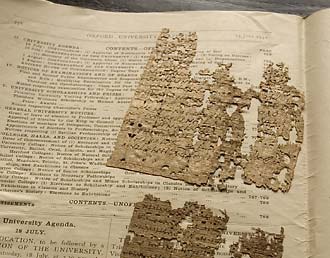British archaeologists Bernard Grenfell and Arthur Hunt excavated the temple, town and cemetery of Tebtunis, Egypt, in an expedition for UC Berkeley in the winter of 1899-1900 at the behest of university benefactress Phoebe Apperson Hearst. After uncovering a treasure trove of papyri and artifacts, they brought them to their home base at Oxford for study and publication of selected pieces.
 Fragments of papyrus rest in pages from back issues of the Oxford University Gazette (in this instance, the 15 July 1931 edition) in which they were shipped back from England. |
After the first two volumes were published, further publication was slowed by the illness and death of the two scholars, so the papyri remained at Oxford for longer than expected, said Todd Hickey, a papyrologist and curator of the Center for Tebtunis Papyri at UC Berkeley's Bancroft Library.
Although much of the material was eventually sent to the campus from the late 1930s through the '50s, additional containers remained overlooked, Hickey said.
But a couple of years ago, Hickey noted that an inventory of the numbering applied by Grenfell and Hunt to many pieces in the center's more than 30,000-piece collection showed many gaps in the sequence. The newly hired curator also noted that a research paper published by a University of Toronto scholar cited pieces of papyri that he studied at Oxford; they contained excavation numbers that identified them as part of UC Berkeley's Tebtunis collection.
"So, we had a pretty good idea there was material at Oxford that belonged to us," Hickey said.
Next, Donald Mastronarde, a UC Berkeley professor of classics and director of the Tebtunis Center, wrote to the chief of Oxford's Oxyrhynchus Center, which houses an extensive papyri collection assembled from a community north of Tebtunis, through the Egyptian Exploration Society.
Oxford University acknowledged possession of some pieces of the Tebtunis papyri collection, said Hickey, and efforts began in earnest to bring them home.
Some of the papers went on display today (Tuesday, Oct. 18) at UC Berkeley in a ceremony at the Morrison Library within Doe Library to celebrate the largest papyri collection in the United States.
Among the new materials are fragments of Euripides' "Phoenician Women," Homer's "Odyssey," an ancient medical handbook, and papers from an influential prophetess of the local crocodile god, as well as a family priest's writings that trace that a family's history over eight generations.
"There remains unknown and potentially blockbuster items in these boxes of mummy cartonnage," said Hickey.
No comments:
Post a Comment